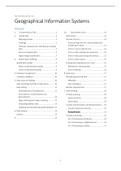Samenvatting
Samenvatting An Introduction to Geographical Information Systems, ISBN: 9780273722595 Geographical Information Systems (NBB)
- Instelling
- Open Universiteit (OU)
Uittreksel van een deel van het boek 'An introduction to Geographical Information systems' van Heywood, Cornelius en Carver, met aanvullingen vanuit het handboek dat uitgereikt is bij het vak Geographical Information Systems aan de Open Universiteit.
[Meer zien]





